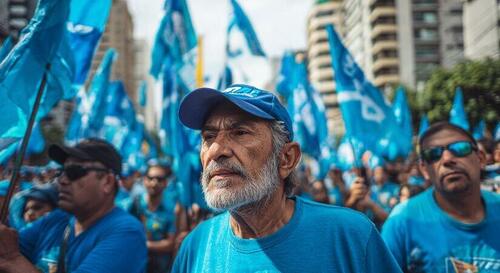
The Rise Of Zohran Mamdani: Why The Radical Left Is Doubling Down On Extreme Socialism
Authored by Brandon Smith via BirchGold.com,
Zohran Mamdani, a 33-year-old New York State Assembly member and self-described democratic socialist, stunned political insiders by clinching the June primary over establishment figures like Andrew Cuomo. His platform is unapologetically bold:
-
An immediate freeze on rent for nearly two million rent-stabilized units
-
A jump to a $30 minimum wage by 2030
-
Publicly owned grocery stores in every borough
-
Free city buses
-
Sharply higher taxes on millionaires and corporations
Mamdani has also courted controversy, refusing to denounce the phrase “globalize the Intifada” (he calls it a „human-rights slogan”) and later insisting he “oppose[s] any incitement to violence.”
He’s promised to use city power to enforce the International Criminal Court warrant and, in a May forum, labeled India’s Prime Minister Modi a “war criminal” over the Gujarat riots.
Here’s what I want you to notice: This is not policy tinkering. Rather, it’s a strategic escalation.
Mamdani’s rise reflects the classic arc of radicalization:
Start with popular grievances, then double‑down into bold, uncompromising extremes.

And for those watching closely, this is a familiar arc: We’re now face-to-face with Batman’s nefarious arch-nemesis, The Joker, unleashed. The Joker’s policies and rhetoric are designed to incite total chaos, in the hopes of entirely disrupting society.
Joker politics: From order to chaos
Batman, of course, represents unflinching law, order and justice. He’s a vigilante, but a vigilante with more respect for the law than most police and politicians in his fictional realm of Gotham City. Batman serves as a potent conservative force, reining in excesses and punishing evildoers in a quest to make Gotham City a safer, better place for its citizens.
The Joker, on the other hand, represents pure chaos and the unhinged, unadulterated desire for power. Not traditional power (the means to control) but a more primal force: The ancient power to corrupt and destroy. The Joker is a pure psychopath who believes his evil is universal and that normal people hide behind “social constructs” to avoid admitting they want to burn down the world just like he does. He revels in the despair of calamity and the fall of moral righteousness.
I’m specifically reminded of Christopher Nolan’s film Batman Begins in which Commissioner Gordon first warns Batman about “escalation” and reveals the calling card of the Joker:
“What about escalation? …We start carrying semi-automatics, they buy automatics. We start wearing Kevlar, they buy armor piercing rounds…”
The left’s rules: Never admit, always escalate
In my analysis of the political left and their behavior I’ve noted many times that they seem random and chaotic but they do follow certain rules.
Rule #1: Leftists never admit they are wrong.
Rule #2: Leftists ALWAYS double down.
In other words, when they think they are losing political power, they will escalate – not tactfully or with dialogue, but with increasingly radical proposals meant to overwhelm and destabilize. Diplomacy is not in their nature; domination is.
This pattern of escalation is exactly why so many conservatives, moderates, and independents gravitated to Donald Trump. His blunt, unapologetic stance against the left’s chaos stood in stark contrast to the incrementalism of establishment politicians. After all, this same chaos gave us pandemic lockdowns, ideological indoctrination in public schools, unchecked street violence, and now a financial environment where interest payments on government debt are climbing by a trillion dollars every few months.
Ask a committed leftist why they’re doing this, and you’ll rarely get a coherent policy rationale. Their answer, directly or indirectly, is usually some variation of: „burn it all down.” That’s not hyperbole – it’s the ethos.
And it’s precisely why Trump’s promise to take a wrecking ball to this agenda gained such traction.
In the early days of this shift, the left didn’t quite know how to respond. Their sources of power – federal funding, NGOs, and corporate backing – began to dry up. Their sphere of influence shrank to deep-blue strongholds like L.A., New York, and Seattle, where progressive officials still shield them from the consequences of their actions.
Which brings us back to New York. What we’re witnessing with the rising popularity of Zohran Mamdani isn’t just a last gasp. It’s a new wave of escalation.
Doubling down on socialism
For years, Democrats avoided openly aligning with socialism, understanding that most Americans – even those on the left – view it with suspicion. The term itself was treated like political poison, and whenever conservatives raised concerns about creeping socialist or Marxist policies, they were dismissed as alarmists or conspiracy theorists.
That tactic is now being abandoned. Increasingly, Democratic candidates and activists are embracing far-left economics and authoritarian state planning not as a hidden agenda, but as a central part of their platform. They’re not softening their rhetoric or disguising their goals – they’re taking off their masks and leaning into the very ideologies they once denied.
Zohran Mamdani is a case in point. Though initially criticized by party insiders as too extreme, his support continues to grow – particularly among young, urban progressives. His defenders argue that he’s bringing moral clarity to the conversation. But look closer at his policies and you’ll see a familiar pattern of failed central planning: rent freezes that reduce supply, punitive taxes that drive out investment, and costly housing programs that may take a decade to deliver results – if ever.
The likely outcome? A mass exodus of middle- and upper-income earners, an eroding tax base, and declining services for those left behind. (It’s already happened in cities like San Francisco and Chicago.) Mamdani’s platform risks pushing New York down the same path.
Still, instead of tapping the brakes, progressive media outlets are promoting him as the party’s future. And Democratic leaders, rather than correcting course after their 2024 collapse, seem ready to double down.
Why? Because in their worldview, admitting error would violate Rule #1.
What comes next
Again, socialism, Marxism, and communism stand in direct opposition to the principles the left most despises: free markets, faith-based morality, national pride, and Western cultural heritage. Whether they realize it or not, many progressives are searching for a radical counterbalance to traditional American values—an ideological Joker to destroy what remains of our Batman institutions.
Could they self-correct? Sure. They could admit their policies have failed, that their ideals are out of step with the majority, and that their efforts to deconstruct American norms have caused more harm than good. But that would mean violating Rule #1.
So instead, as populist sentiment continues to build and Americans grow increasingly skeptical of globalist priorities, the left is likely to retreat further into ideological extremism. They may even gain short-term momentum. We’ve already seen it elsewhere:
-
Canada: The backlash against Justin Trudeau’s failed leadership has not led to moderation but rather opened the door to Mark Carney – an economic globalist poised to carry the same agenda with a sharper edge.
-
Germany: following frustration with center-left coalitions, far-left parties like Die Linke have gained traction by proposing radical redistribution schemes and aggressive climate mandates.
-
Australia: the rise of the Greens and far-left independents in reaction to center-left Labor compromises has shifted national debates toward more radical territory.
This pattern is global: when progressive leaders fail, the left doesn’t pivot to moderation. They seek out even more uncompromising ideologues to carry their banner.
This is the cycle: when progressivism fails, it doesn’t reform – it doubles down.
So what does this mean for the rest of us?
I believe it’s prudent to prepare for both political and economic turbulence. Expect more civil unrest, more authoritarian proposals, and more erosion of economic freedom.
But that doesn’t mean we’re powerless.
One of the most effective things individuals can do is protect their financial future from systemic instability. When institutions crumble or fiat currencies falter, history has shown that physical assets like gold and silver can help insulate savings from the chaos. While some prepare for societal collapse with bunkers and bug-out bags, the more strategic move may simply be this: transfer a portion of your wealth into something that doesn’t burn.
In uncertain times, gold isn’t just a hedge – it’s Batman’s utility belt. It’s what you reach for when chaos reigns and the usual tools of defense no longer work. When the Joker lights the fuse, physical gold and silver serve as a fortress – real assets that endure, even in a world set ablaze by ideological arson.
Tyler Durden
Mon, 07/28/2025 – 22:35













